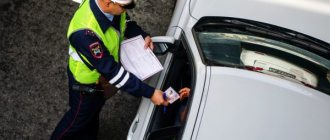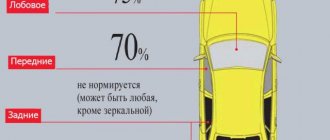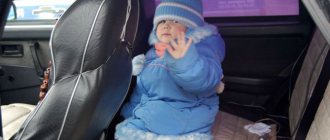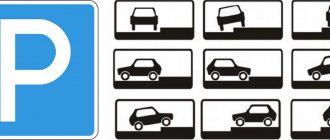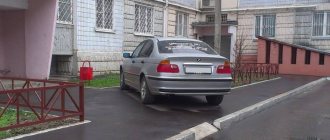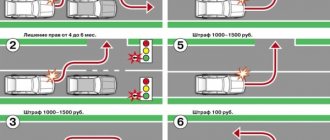Is it possible to use frame curtains according to traffic regulations?
You can, but not on the front windows, otherwise there will be a fine. And this is what the legislation says regarding the issue we are discussing!
The direct answer to this is contained in the Basic Regulations for the Admission of Vehicles to Russian Roads (this is the Appendix to the Traffic Regulations). Thus, paragraph 7.3 of the Rules indicates that:
- It is prohibited to place any objects or coverings that limit visibility from the driver’s seat - and in practice, the area of such visibility is considered to be the front hemisphere: windshield and side front windows,
- however, it is possible to install specific frame shades on rear windows, provided that your vehicle is equipped with both side mirrors.
A similar requirement is also contained in the Technical Regulations in paragraph 4.3 of Appendix No. 8. It also prescribes that the light transmittance of the front hemisphere must be at least 70% - that is, the front windows must transmit at least 7/10 of the total light, and no frame curtains, unfortunately, can provide this.
As for the formulation of visibility given above - that it is provided by the front and side windows at the front, confirmation of this is also contained in the Technical Regulations at the very beginning of the document - general provisions, definition of visibility.
We analyze the current legislation
So, paragraph 7.3 of the List of Faults indicates that if visibility from the driver’s seat is limited by any objects, then operation of the vehicle is prohibited. At the same time, operation in this case implies using the car for its intended purpose - driving it.
And Part 1 of Article 12.5 of the Code of Administrative Offenses of the Russian Federation punishes even specifically for driving in the presence of conditions or malfunctions from the above List.
Visibility from the driver’s seat in this case is provided by the front “hemisphere”: windshield and front side windows. Thus:
- Trokot curtains cannot be placed on the front hemisphere of windows,
- but it is not prohibited to install them on the rear side windows and the rearmost traffic rules.
Please note that there is a difference here from conventional film tinting, in which the rear hemisphere can only be tinted if both rear-view mirrors are present. This condition contains the Technical Regulations on the Safety of Wheeled Vehicles. Paragraph 4.3 of Appendix 8 states this directly. But we are still talking about film, and not about frames, so in our case only the front hemisphere works.
Some curtain manufacturers assure potential customers that their curtains supposedly undergo light transmittance measurements. But this does not matter in the legislation of 2021. Measurement is required in the case of films. And they are separated from “additional items” in the same paragraph 7.3 of the List, for example.
And the fine for filming is provided for under another norm of the Administrative Code - Part 3.1 of Article 12.5. There we are talking specifically about glass with insufficient light transmittance. In our case, frame curtains are not part of the glass, but objects that, as we cited above, are illegal.
Other manufacturers simply refer to the experience of communicating with traffic police inspectors of drivers with their curtains installed on their cars. For example, on Trokot’s official website they link to one of these videos:
Below, the very first in the list we have attached this video.
In this video, the traffic police inspector does not react at all to the installed Trokot curtains. Of course, the fact that the employees did not fulfill the duties assigned to them by law to ensure road safety means that the employee himself must be held accountable - at least disciplinary.
But Trokot does not limit visibility!
Meanwhile, one of the most popular arguments of a number of manufacturers of these items, as well as motorists, when trying to challenge the decisions of the traffic police lies somewhat differently. Namely, in the incorrect interpretation of the law.
The point is that the curtains supposedly do not limit visibility from the driver’s seat – at all. “An additional item that limits visibility” is, for example, a video recorder on the glass or a navigator, various kinds of souvenirs and fragrances on the instrument panel, which at least somewhat block the visibility area.
The curtains on the windows have the shape of a grid, so they do not block anything from the driver. That is, the main criterion for violating traffic rules here is the supposed opacity of these items. Even a roof support pillar can be caught by some car owners as a prohibited item. But not the curtains.
This argument has no right to life for one simple reason. When trying to appeal a fine for blinds on this basis, the person hearing the case or the judge can actually delve into the case and begin to figure out what constitutes visibility. There is no such definition in the traffic rules. And the courts in this case are looking for normative acts that are similar in gender, where it may be.
And they will find it in the Technical Regulations. According to this legal act, visibility is a property of the car’s design (glass in our case), which characterizes the objective possibility and conditions for the driver to perceive visual information about the road, which makes it possible to control the road for road safety purposes.
But what completely and completely blocks part of the visibility has its own definition in the same paragraph of the regulations, and is called the “blind area”.
Thus, objects that limit visibility from the driver’s seat do not necessarily have to be things that create a blind area. Trokot curtains are also such, since they violate the objective possibility of perceiving visual information. And if you take into account how they often dazzle the driver’s eyes, then they can be considered objectively dangerous for road traffic.
What is the fine for curtains?
Violations of operating rules are subject to Article 12.5 of the Administrative Code. Specifically, part 1 of this article provides for a fine of 500 rubles or a warning.
It is illegal to apply Part 3.1 of Article 12.5 of the Code of Administrative Offenses for curtains on windows - as for tinting, because it prescribes a fine for glass with film and with light transmittance contrary to the requirements of the Technical Regulations - less than 70%.
But, in addition to the fine, in practice other sanctions are applied. More on this below.
If collected
Please note that we indicated above when curtains are legal according to traffic rules and when they are not. If they are assembled and completely located at the central pillar - and they should be assembled on both the driver and passenger sides - then nothing interferes with visibility. That's why there shouldn't be a fine.
In other cases, a fine for curtains on car windows is legal.
Is there a penalty for curtains at the back?
No. The curtains on the rear side windows do nothing to limit visibility. As for the rear window, the question here is twofold - when looking in the interior rearview mirror, the curtains formally interfere with the view. However, by analogy with tinting, nothing prohibits tinting the rear window at least tightly if there are external side mirrors.
Can they be deprived of their rights?
No. The law does not provide for a deprivation clause for curtains for 2021; there is no such provision in the Code of Administrative Offenses of the Russian Federation.
The closest thing to analogy that can be drawn is the development by legislators of a law providing for a gradual tightening of penalties for repeated driving of an excessively tinted car. But we are talking specifically about tinting - we remind you that curtains are not tinting, and they have different penalties.
But the bill itself on deprivation for tinting is currently in the development stage - its official adoption is still far away.
Can a fine be considered unreasonable?
Many drivers believe that traffic police officers and its divisions are acting unlawfully when they demand that the owner of the vehicle pay a fine. According to explanations given by specialists in the field of administrative law, traffic police officers do not have the right to fine motorists who have curtains or a thick mosquito net attached to the rear window.
You can be fined for curtains on the side windows. It all depends on the traffic police inspector and on you. You can try to prove that the curtains are used only in the parking lot, and the rest of the time they are open.
Persons who do not want to give up curtains and mosquito nets are advised to:
- use curtains/mosquito nets made in accordance with GOST : they should not block the viewing angle;
- their transparency should not be less than 70%.
Video: Driver stopped behind curtains
By the way
The fine introduced for the use of tinted windows helped reduce mortality statistics on Russian roads. According to traffic police data, in 2014 the number of accidents decreased by 3 times (compared to 2013). In the new year 2021, Russians can expect more favorable forecasts.
Can curtains be removed?
Yes. In practice, when issuing a decree with a fine for an item that limits visibility, a traffic police officer can seize the curtains as material evidence. But this is illegal.
According to the Administrative Regulations of the Ministry of Internal Affairs, introduced by Order No. 664, its paragraph 213:
213. The basis for the seizure of things that were instruments of committing or subjects of an administrative offense, and documents that have the value of evidence in a case of an administrative offense, is their discovery at the scene of the commission of the administrative offense.
But the legislation contains a specific list of items possible for seizure, and curtains are not included there. To verify this, just read the following paragraph of the regulations - 214:
214. When administrative offenses provided for in parts 1 and 2 of Article 12.4, parts 3, 4, 5 of Article 12.5 of the Code are detected, lighting devices with red lights or red reflective devices are confiscated, as well as lighting devices, the color of the lights and the operating mode of which are not comply with the requirements of the Basic Provisions.
And for curtains on the windows, Part 1 of Article 12.5 of the Code of Administrative Offenses applies. In fact, the violation is driving a car with curtains. And there is no instrument for committing a violation here. Otherwise, the car itself, in which, for example, the driver exceeded the speed limit, could be confiscated, because logically, in this case, it is also an instrument of the offense!
However, when detected in practice, curtains are often removed. We are not talking about confiscation here, but rather about seizure, and as a result of the latter, the object of the crime must be returned after the end of the administrative case - the issuance of a resolution.
Can they be confiscated?
No. It is illegal to confiscate curtains if the driver is charged under Part 1 of Article 12.5 of the Code.
Confiscation as an administrative measure is applied for certain offenses; their list is clearly stated in the relevant articles of the Code of Administrative Offenses. For example, illegal fishing and hunting tools are subject to confiscation. But the 2021 law does not directly provide for curtains to be irrevocably taken from the driver within the framework of just a resolution under Part 1 of Art. 12.5 Code of Administrative Offences.
Are curtains on front windows allowed in 2021?
No. It is illegal to confiscate curtains if the driver is charged under Part 1 of Article 12.5 of the Code.
Confiscation as an administrative measure is applied for certain offenses; their list is clearly stated in the relevant articles of the Code of Administrative Offenses. For example, illegal fishing and hunting tools are subject to confiscation. But the 2021 law does not directly provide for curtains to be irrevocably taken from the driver within the framework of just a resolution under Part 1 of Art. 12.5 Code of Administrative Offences.
No. Requirements and orders to eliminate violations issued by traffic police officers for tinting do not apply to curtains.
Not only are such requirements themselves not provided for by law. In practice, we also do not know of a single case where a traffic police inspector issued a demand for curtains on the windows of a car, and then such a driver would be given administrative arrest (Article 19.3 of the Code of Administrative Offenses for failure to comply with a legal requirement).
So, to answer this question we need to understand what types of curtains there are. And they come in the following two main types:
- frameless (look like curtains on the windows of a house),
- frame.
In fact, there are many more types of curtains, but we will consider only these two from the point of view of traffic rules; the remaining types can be classified as frame ones according to their legality.
Since curtains are installed on car windows, we need to look specifically at the list of faults that regulate the technical component of the car and additional components. Specifically, we need clause 7.3 of the List of faults for which the operation of the vehicle is prohibited:
7.3. Additional objects have been installed or coatings have been applied that restrict visibility from the driver's seat.
As you can see, the 2021 traffic regulations prohibit any objects and coatings on the glass, but only if they limit visibility and only from the driver’s seat.
That is, the answer to the question whether curtains on windows are prohibited by traffic regulations depends on whether they somehow limit the driver’s visibility.
- frame curtains, when installed on windows, in all cases limit visibility, therefore they are prohibited according to traffic regulations,
- Frameless curtains are limited only when they are curtained, but if they are assembled, then they are allowed for 2021.
An important subtlety here is that the prohibition of clause 7.3 applies specifically to the operation of a vehicle, since this clause is from the list of faults and conditions under which it is prohibited to operate the car. And what we mean by exploitation here is management. If the car is parked with curtains, then you will not have to pay a fine.
Violations of operating rules are subject to Article 12.5 of the Administrative Code. Specifically, part 1 of this article provides for a fine of 500 rubles or a warning.
It is illegal to apply Part 3.1 of Article 12.5 of the Code of Administrative Offenses for curtains on windows - as for tinting, because it prescribes a fine for glass with film and with light transmittance contrary to the requirements of the Technical Regulations - less than 70%.
But, in addition to the fine, in practice other sanctions are applied. More on this below.
Are fines issued in practice?
Yes, sure. Moreover, quite actively - even though frame curtains are not such a favorite violation detected by traffic police officers as film darkening of windows, however, this type of removable tinting is also quite often punished by traffic police inspectors on the road.
This happens quite standardly:
- you are driving along the road and you see an inspector, who, in turn, sees your car from afar with frame curtains (more precisely, only when you drive up to him will he discover that this is removable tinting, and from afar you will simply see an object that restricts the view and the interior is too dark),
- the policeman stops you and simply issues an order under Part 1 of Article 12.5.
Is light transmittance measurement required?
No, this is not necessary for frame curtains, so the above are only 2 simple points in the scenario of holding such a driver accountable.
Here we should generally distinguish between 2 different norms of punishment:
- 12.5, part 1 – 500 rubles – for objects that limit visibility (on the front windows), this is a legal fine for frame curtains in 2021,
- 12.5, part 3.1 – for coatings or objects on glass that do not provide the light transmission required by the Technical Regulations (at the same time, the Code of Administrative Offenses directly refers to a violation of the regulations).
The technical regulations, in turn, indicate that the front hemisphere must transmit at least 70% of sunlight (and not only) light.
Thus, the cardinal difference between these two measures of responsibility is that under Part 3.1 you can be fined specifically for the light transmittance of the glass itself - with or without films. But part 1 is specifically for items that limit the view. Therefore, in the case of frame curtains, the fine is issued specifically for 1 part. And measuring light transmittance is meaningless here.
What is better, tinting or frame curtains?
It’s no joke, but both of these norms of sanctions provide for exactly the same penalties: either a warning (which, by the way, in practice in 2021 is issued very rarely and in exceptional cases) or a fine of 500 rubles.
But the answer to the question of which method is safer to use in terms of a fine: frame curtains or regular film tinting, becomes obvious if you know that the police today are practicing a rather interesting additional method of dealing with the latter. And it is called “a requirement to eliminate the conditions entailing a violation.” Or the same “warning”.
The essence of this is that by installing the film, you are a priori going to violate, although you do this only while driving a vehicle (if the car is stationary, you can at least board up the windows with plywood).
We explained in detail why such a requirement is illegal in one of our previous articles. However, despite the illegality, inspectors continue to issue such papers, and judges imprison drivers for up to 15 days under Article 19.3 for disobeying the allegedly legal demands of a police officer.
In the case of frame curtains, such requirements are practically not issued - only fines, therefore, from the point of view of bringing to responsibility, using curtains is, as it were, “safer”.
If you managed to remove it?
It's not that simple here. Frame curtains have a wonderful advantage - they can be removed not only before communicating with the traffic police, but often even before the officer stops you. But this life hack doesn’t work very well for a car enthusiast.
Let’s say an inspector saw you on the road while driving with curtains, but you managed to remove them, and when the policeman approached the car, there was no violation. But he saw them!
In this case, the Administrative Code obliges the traffic police officer to conduct an inspection of the car, since this procedure is carried out in order to search for instruments of committing an offense:
- the inspector draws up an inspection report,
- attracts 2 witnesses or includes a video recording,
- searches and finds frame curtains,
- issues a resolution or draws up a protocol for further consideration (in the latter case, the curtains will most likely be confiscated from you - we’ll talk about this a little below).
What fine will be issued for curtains on the front windows in 2021?
This is not provided for by law. Confiscation of curtains upon attracting a driver under Art. 12.5 will be against the law. Confiscation as an administrative penalty is used only for certain violations. Their list is precisely indicated in the Administrative Code. For example, prohibited hunting and fishing tools are confiscated.
But according to the law, car curtains are not permanently confiscated from the car owner under such penalties.
This action is not provided. Instructions and requirements for eliminating violations issued by traffic police inspectors for tinted windows are not issued for curtains.
In addition, even by law such requirements do not exist. There have been practically no cases where a traffic police officer would issue a warrant for curtains, and then the car owner would be arrested for failure to comply with the requirements.
At the same time, the Rules allow the use of curtains, nets, and blinds on the rear windows. The light transmission of the rear windows can be any if the vehicle is equipped with two working rear view mirrors. “It is allowed to use tinted glass (except for mirror glass), the light transmission of which complies with GOST 5727-88. It is allowed to use curtains on the windows of tourist buses, as well as blinds and curtains on the rear windows of passenger cars if there are external rear-view mirrors on both sides.”
On the front windows, light transmission must comply with GOST standards, that is, be at least 70%. Curtains and frame nets on car windows instead of tinting, installed on the front windows, should not limit the driver’s visibility and have a light transmission of at least 70%. Otherwise, driving such a vehicle is prohibited.
Penalties apply only to those drivers who used the curtains directly while driving. If the car is in a static position, you can close the curtains. In some cases, a fine is replaced with a warning:
The amount of the fine in 2021 under Part 3 of Art. 12.5 of the Code of Administrative Offenses of the Russian Federation is 500 rubles. This regulation affects any means that are installed on a car to darken the interior. Thus, using curtains is punishable in the same way as driving with tinted windows.
Curtains in cars came into fashion after the ban on window tinting. Many motorists believe that curtains will protect them from scorching sun rays, overheating of the car, and even from the fine that is issued for tinting.
So, the fine for curtains on the front windows in 2021 is only 500 rubles. But this does not mean that you need to break the rules and regularly pay penalties. It is easier to purchase mesh or curtains with the permitted level of light transmission. Then it won’t be so light and hot in the car, and the law won’t be broken.
Is there an order or requirement for curtains?
In fact, the main purpose for which State Traffic Inspectorate employees issue orders or demands is the opportunity to prosecute the driver for a repeated violation if the malfunction is not eliminated, and impose a more severe penalty - a fine of 500-1000 rubles or arrest for up to 15 days (under Part 1 Article 19.3 of the Code of Administrative Violations).
In relation to curtains, neither an order nor a requirement can be issued - such punishment is not provided for by law. There are also no similar precedents in judicial practice. But unfortunately, a prescription may be issued for tinting.
Penalties
Motorists are fined for using curtains and nets installed on the front windows of the car and not meeting the requirements governing the transmission of sunlight. They are regulated by a set of traffic rules. Accessories are prohibited in the following cases:
- If driving with 70% light transmission blinds down, the driver may be given a verbal warning or a fine. The penalty is established depending on the driver’s previous violations, as well as the decision of the traffic police inspector.
- When attaching a mesh that does not meet the light transmission requirements of GOST, the car owner is fined.
Note!
If, when driving, there is any tuning on the car windows, including mesh or fabric, a traffic police officer may impose a fine of 500 rubles.
The inspector also has the right to confiscate the instruments of the offense in accordance with Part 1 of Article 27.10 of the Code of Administrative Offences. When drawing up a protocol, the presence of two witnesses is necessary, who subsequently certify it with their signatures.
There is another withdrawal option. At the same time, there is a record of how the weapon of dispute was confiscated. You must first obtain permission from the court. Then the offender is warned that a seizure procedure will be conducted on video camera. Only after this can you begin the procedure.
Interesting!
If the traffic inspector did this using his personal phone, such seizure has no legal force.
Is it legal to seize car curtains?
Removing curtains is a common procedure for traffic police representatives. But this does not make it legal.
According to paragraph 213 of the Administrative Regulations of the Ministry of Internal Affairs, objects that were instrumental in committing an offense can indeed be confiscated. But the very next paragraph of this document provides a list of what can be confiscated - special signals and lighting devices that do not meet the standard.
In addition, the curtains cannot simply be confiscated - the inspector is obliged to draw up an inspection protocol and involve witnesses, as well as draw up an additional protocol for the seizure of the weapon of the offense. Based on these documents, the motorist can appeal the decision and return the things that belong to him. Both at the level of the traffic police department and the court, the actions of the confiscation inspector will be recognized as illegal, and he will be required to return the item.
Thus, representatives of the State Traffic Inspectorate have the right only to demand the removal of the curtains - that is, the elimination of the reason prohibiting the operation of the vehicle.
Do you have to return it after seizure?
Yes. In our case, part 3 of Article 29.10 of the Code of Administrative Offenses provides that seized items must be returned to their rightful owner after consideration of the case. The only exceptions are situations when:
- the owner of the frame curtains is not identified,
- the item is prohibited (drugs, weapons, etc.), and curtains are not one of them.
Therefore, any removable tint must be returned to the car owner after removal. This is done precisely after the consideration of the case. If a traffic police officer issued a fine for using frame curtains on the front windows on the spot, then he must return it immediately.
There is also no need to prove that these curtains are yours, either by receipts or by any other means. By default, in administrative law, the presumption of innocence also implies a presumption of ownership - that is, for example, you can not drive your own car, and when you drive someone else’s car, you are not asked for a written power of attorney. The same goes for curtains - they may not be yours, but they must be returned to the owner. Possession and ownership are two different things. The first includes the ability to dispose of property.
Legal requirements for the use of curtains in a car
Many drivers are often too confident that they are right and mistakenly believe that inspectors do not have the right to impose a fine for frame curtains.
Their misconception is based on the absence of a specific prohibition in the Code of Administrative Offenses on the installation of curtains on the front side windows. The fashion for frame curtains appeared in the country after the introduction of a ban on thick tinting of car windows. They perform the protective functions of the interior, protecting it from the sun, prying eyes and mosquitoes. But in addition to their benefits, curtains also pose a danger, blocking the driver’s view and causing an accident.
This device, compared to tinting, has a clear advantage, since the curtains can be moved if necessary. But many drivers, ignoring this possibility, drive in a car with the curtains closed, attracting the attention of the traffic police. Their actions are most likely related to a lack of awareness of whether curtains on the front windows of vehicles are allowed.
This is due to the fact that according to the law there is no distinction as to exactly how the windows are tinted. If the light transmittance is less than that required by law, the vehicle is not permitted to be operated. This offense is quite clearly stated in Article 12.5 of the Code of Administrative Offenses . In accordance with this article, curtains belong to the category of blackout films. Not meeting traffic safety requirements.
The use of curtains is also prohibited in accordance with the “List of Malfunctions...”, paragraph 7.3 of which does not allow the installation of objects in the car or the application of coatings that limit the driver’s visibility. So this document contains a direct ban on operating a car with curtains.
Appeal against punishment
If the driver is guilty of an offense and all the evidence is clear, it is useless to try to appeal the decision. But there are also situations when a traffic police officer exceeds his authority and imposes an illegal penalty on the driver for having:
- curtains, even if they are assembled and do not interfere with the view;
- frame curtains in a parked car;
- rear curtains, etc.
If this punishment is unlawful, the car owner needs to collect evidence - take photos and videos, and also indicate the fact of disagreement with the protocol.
An application with attached evidence can be submitted to the head of the traffic police department, whose representative issued the fine, as well as to the court (within 10 days). If the motorist manages to prove that he is right, the fine will be cancelled.
How to get away with curtains?
There are several useful tips from lawyers that can help avoid a fine:
- You may be required to measure the light transmittance of the curtains, and the absence of a device and measurement “by eye” can be interpreted as a reason why a fine cannot be issued.
- You can refer to Article 12.5 Part 1 and ask to limit yourself to a warning, promising the inspector to remove the curtains and no longer use them while driving.
- You can remove the curtains before the inspector approaches the vehicle. But this trick will only work if there was no video recording of the violation.
How to challenge a fine
The collection of a fine by an inspector when driving a car with folded curtains is considered unfounded.
And such a punishment can and should be challenged in higher authorities. Although, not wanting to waste time, drivers most often sign the protocol drawn up and pay the fine, considering the amount of 500 rubles not so big. But if you take a principled position on this issue, then the fine should be paid only if there is a violation.
If you disagree with the imposition of a fine, lawyers advise you to act as follows:
- If the curtains or mesh on the glass have an acceptable light transmittance, you must request that the inspector take measurements. In the absence of an appropriate device, the inspector does not have the right to issue a fine, focusing only on visual indicators. If the inspector does draw up a protocol, it does not need to be signed. You must make a note of your disagreement in the protocol and take a copy of it in order to later attach it to the complaint against the actions of the traffic police officer.
- If curtains made of thick fabric are attached to the windows, they must be pulled apart immediately when stopping. An inspector can prove that the car was moving with the curtains closed only if a video recording was made.
- If the car was driving with the curtains open, and the inspector insists on the existence of a violation, it is necessary to make an entry in the protocol and immediately file a complaint.
And finally, I would like to remind you that no comfort is worth risking your own life. Blocking your view with thick curtains. While driving, nothing should interfere with the driver, so driving a car with thick blackout curtains on the front windows is still not advisable. This will help avoid not only a fine, but also accidents on the roads.
In the video, traffic police officers explain what the fine is for having curtains on the front windows.
What is the fine for unreadable numbers?
So, the very first part of Article 12.2 states that the driver is subject to a warning or a fine of 500 rubles for unreadable license plates. Please note that a fine is imposed only for driving a car with unreadable license plates or one license plate. If the car is stationary, there is no fine for this.
In what cases are numbers considered unreadable? The numbers will be recognized as such by the traffic police inspector if he fails to read at least one letter or number from a distance of 20 meters (note to Article 12.2). At the same time, the inscription “RUS” and the image of the flag may be unreadable, there is no fine for this. There is a difference in unreadability depending on the time of day. Since the front number plate is not illuminated in the dark, there is no requirement for its readability from 20 meters, but the rear number plate must be readable at any time. During daylight hours, both license plates should be readable - again, from a distance of 20 meters.
At the same time, the unreadability of numbers here does not include that due to their concealment and modification. The reasons for unreadability can be, for example, the following:
- the room is covered in dirt, snow, etc. (not on purpose, of course)
- the number has been erased (the black letters or numbers on the number have been erased),
- something accidentally stuck to the number (precisely by accident, but this may be a controversial point).
Is it possible to hang car blinds on side windows?
- use curtains/mosquito nets made in accordance with GOST : they should not block the viewing angle;
- their transparency should not be less than 70%.
In addition to being useful, such a detail can also lead to dire consequences: according to statistics provided by the traffic police service, the majority of accidents that occurred in 2021 were caused by the curtains that tightly curtain the side windows. They significantly limit the viewing angle available to the driver. The elements of this offense are stated in the first paragraph 3 of part of article 12.5 of the Code of Administrative Offences:
What is the fine for license plates installed in violation of GOST?
The same part of the article provides for a similar fine of 500 rubles for numbers that are installed in violation of the requirements of GOST R 50577-93. The list of such requirements is quite broad, but quite understandable and memorable.
Let's list how it is prohibited to install license plates in order to get fined for incorrectly installed license plates:
- the number must be installed perpendicular to the length of the car with a deviation of no more than 3°;
- the number must be installed perpendicular to the road surface with a deviation of no more than 5°;
- the distance from the road surface to the bottom edge of the sign must be at least 30 cm, and for two-wheelers and snowmobiles - 20 cm;
- Visibility should be ensured at the following angles in the diagram below:
- the number can only be attached to the holes on it with light-colored bolts or other light-colored elements;
- you can attach the number to the frame, but the frame should not cover the letters and numbers of the license plate (as well as the bolts in the holes);
- It is prohibited to drill additional holes into the license plate.
The fine here is also provided only for driving a car with such violations.
What is the penalty for hidden numbers?
Hiding numbers in 2021 is punishable by more severe penalties. And a fine is not the only punishment here. For a deliberately hidden license plate, a fine of 5,000 rubles or deprivation of rights for 1-3 months (by decision of the official or judge considering the case) is imposed under Part 2 of Article 12.2 of the Code of Administrative Offenses. Only driving a car with hidden license plates is punishable in the same way.
Meanwhile, the line between hiding the number from being readable and making the license plate unreadable is quite thin. And the main factor here is precisely the intentionality of the concealment. If the room was deliberately splashed with mud or snow, then this is a cover-up; if by chance, then an unreadable number.
A reasonable question is how will a traffic police inspector determine whether the number is hidden intentionally or unintentionally? Alas, but at your own discretion. According to the Code of Administrative Violations, the composition of many violations and the driver’s guilt in them are determined by the body considering the case based on personal conviction, but having comprehensively and most fully considered all the circumstances and evidence (26.11 of the Administrative Code). You, if a decision is made not in your favor, can appeal such decisions.
Concealing a number includes such actions and circumstances as:
- use of curtains on rooms;
- the use of reflective film (the above GOST generally prohibits applying any coating to the number);
- covering the numbers with any objects (paper, rag, etc.);
- deliberately staining the license plates with mud, snow, clay, etc.;
- and another case described below...
Fine or deprivation of rights for upside down numbers
The fact is that such a “life hack” as inverted numbers, which allows you to avoid punishment from auto-fixation cameras, is practically not described anywhere in legislative acts. GOST for license plates also does not prescribe that the numbers must be placed so that they are not read upside down or that the back and front parts of the license plate must not be swapped.
And here the issue is not so easily resolved, including in practice. If the number is turned upside down, then the punishment for this can be either under Part 1 or Part 2 of Article 12.2 of the Code of Administrative Offenses. At the same time, logic dictates that there may not be a violation at all in this case. The fact is that an upside down number is quite readable, and the inspector doesn’t even need to break his neck to do this - everyone can read the text upside down.
On the other hand, GOST stipulates that the white stripe of the Russian flag should be on top and the red stripe on the bottom:
The image of the State Flag of the Russian Federation should be a rectangle with equal horizontal stripes: the top stripe is white, the middle stripe is blue and the bottom stripe is red.
But here again, with the violation, not everything is so simple. This note in GOST refers to the installed types of license plates themselves and has nothing to do with the requirements for their installation on a car. That is, the flag still remains in the correct position relative to the top and bottom edges of the number itself - it’s just that the number is hung upside down on the car. Simply put, the white stripe of the flag is on top of the number (but from below towards the road), and this GOST clause refers specifically to the position relative to the number.
But having an upside-down license plate with the front side facing the car, when its back side is visible, can be punishable by Part 2 of Article 12.2 with possible deprivation of rights. This is because in this case there is a deliberate intention to hide the number. That is, the official examining the case, in practice, usually concludes that a license plate deliberately directed with its front side towards an obstacle is an obvious concealment of the number.
What is the fine if numbers are placed on glass?
For driving a vehicle whose license plates are installed outside the place provided by the design, in 2021 you will also be punished under Part 2 of Article 12.2 of the Code of Administrative Offenses. Including if you put the license plates behind the glass in the car, and even if they are clearly visible from 20 meters away.
But what to do if there are no places provided by the design of the car at the moment. For example, if you removed the bumper or it was broken, and the numbers are installed on the bumper? Unfortunately, it is prohibited to travel in this case. Dura lex - sed lex (from Latin “the law is harsh, but it is the law”).
○ How to replace auto curtains?
What should a driver do who still wants to protect the car interior from the sun, insects - and, finally, just from prying eyes? There are several options here:
- You can still use car curtains - but only when parked, and when driving - only on the rear doors and rear window. At the same time, in the closed position, the curtains should not protrude beyond the dimensions of the racks.
- Use of transparent meshes. This option is especially relevant for cars that are not equipped with air conditioning: the nets trap insects, flying debris - and, to some extent, dust. However, here you need to ensure that the transparency of such grids is at least 70%.
- The use of visors and tinting on the upper part of the windshield is permitted.
- Finally, on sunny days, it is better for the driver to use sunglasses than tinting or curtains. In this case, you can choose their transparency yourself according to your taste - they have no right to find fault with you.
What is the penalty for false numbers?
But the most severe punishment in terms of car license plates awaits the driver for driving with false license plates. Let’s imagine a not very common situation: entry into the closed territory of an organization using passes issued for a car number, and a camera that records the number and automatically opens the barrier, if there is one in the database. You arrived in a different car, but took with you the number registered in the database and put it on top of the current number in order to drive through the barrier.
If such an action is seen by a traffic police officer, then you will face two punishments at once: the first - for the very fact of installing false license plates, the second - for driving with false license plates. For installation you will face a fine of 2,500 rubles, but for management you will be deprived of your rights for a period of six months to a year.
What to do if you receive this fine?
Fine for unreadable numbers in 2018
If a fine was received for frame curtains, the traffic police officer must issue a corresponding receipt, according to which the debt will have to be repaid within 60 days. Sometimes the receipt is not issued on the spot, but is sent by mail to the registration address of the car owner. But the first method is more often used, and the second is intended for those offenses when there is no direct contact with the driver (for example, speeding under a camera). When receiving a receipt by mail, 60 days from the date of receipt of the notice are also given to repay the debt.
Note! If you pay the fine within the first 20 days from the receipt of the receipt, you will receive a 50% discount, that is, half the amount is enough.
If the fine is not paid after the expiration of the period allocated by law, then it will subsequently be paid in double amount, that is, it will already amount to 1000 rubles. If, after the allotted 60 days, the violator is again stopped by traffic police officers, and the fine is not paid, then an additional fine of five hundred rubles is issued for evasion of payment. Thus, ignoring a fine may cost 1,500 rubles instead of the required 500 (or 250 in case of quick repayment).
In Russia, the size of this fine and the details of its repayment do not depend on the region in which the incident occurred.
Fine for curtains
Table of fines for numbers
The table below shows all fines and other preventive measures relevant for 2021 regarding violations of license plates, including those not described above.
| Violation | Punishment | Comments |
| Dirty rooms | 500 rubles | Only if it is not intentionally covered with dirt. |
| The rooms are covered with snow | 500 rubles | Only if it is not intentionally covered with snow. |
| The numbers have faded with time | 500 rubles | The black paint on the license plate has worn off. |
| The erased number is tinted by hand | From nothing to a fine of 5,000 rubles or deprivation of rights for 1-3 months. | It all depends on how carefully the number is painted and, accordingly, the availability of composition for modifying the number. |
| The number is secured with black bolts | 500 rubles | For violation of GOST for attaching license plates |
| The letters or numbers of the number are covered with bolts or a frame | From 500 to 5000 rubles or deprivation of rights for 1-3 months. | It depends on the resume of the traffic police officer and/or the judge whether the number is modified/hidden or not. |
| The number is unreadable from the viewing angle required by GOST | 500 rubles | See above for the diagram of the required license plate visibility angle. |
| Additional holes drilled in the room | 500 rubles | For violation of GOST for attaching license plates. But only if the letters or numbers of the number are not covered with bolts or drilled with such holes. |
| Curtains on the rooms | 5000 rubles or deprivation of rights for 1-3 months. | It does not matter whether the rooms are closed with curtains or not - the very fact of driving with such equipment or material is punished. |
| Film on license plates | 5000 rubles or deprivation of rights for 1-3 months. | It doesn’t matter whether the numbers are covered with film or not - the very fact of driving with such material is punished. |
| Specially erased or added letters or numbers | 5000 rubles or deprivation of rights for 1-3 months. | — |
| The number is blocked by a foreign object | 5000 rubles or deprivation of rights for 1-3 months. | The room is covered with a rag, a sheet, a sticker, deliberately stained with dirt, snow, etc. (the intent is obvious). |
| Upside down number | 500 rubles | In practice, this may result in deprivation of rights with an alternative fine of 5,000 rubles. |
| The number is hung with the back side facing out | 5000 rubles or deprivation of rights for 1-3 months. | The number is hung on the car “inside out”: the back side is away from the car, and the front side is towards the car. |
| Fake number | Fine 2500 + deprivation of rights for six months to a year | A fine for installing a false license plate, and imprisonment for driving with a false license plate. |
| Driving without license plates | 5000 rubles or deprivation of rights for 1-3 months. | If at least one number (front or back) is missing. |
| Rooms covered with cargo | 500 rubles | Fine under Article 12.21 of the Code of Administrative Offenses for violation of cargo installation. Read the full article about closing the number with cargo. |
○ Current fines for installing curtains.
Now let’s figure out what the culprit faces if he violates the traffic rules regarding car curtains.
Installing curtains where they should not be is considered an offense under Art. 12.5. However, which specific part will be used depends on the specific situation:
- Part 1 – if blinds or auto-blinds are used, that is, a separate device mounted on the frame separately from the glass;
- Part 3.1 - for grids and other devices that are attached directly to the glass and can be considered as a coating (a kind of tinting).
Oddly enough, the punishment in both cases will be the same: both parts provide for a fine of 500 rubles. However, in the case of Part 1, there is still the possibility of issuing a verbal warning . Usually it is used if the driver is “clean” in terms of violations, and the inspector himself is in a good mood.
In addition to a fine, the culprit may also face confiscation of the curtains themselves , which in this case are an instrument of the offense. This possibility is provided for in Part 1 of Art. 27.10 Code of Administrative Offenses of the Russian Federation.
However, this requires either an official video recording (filming made by the inspector on a personal phone cannot be considered!), or two witnesses signing the protocol.

